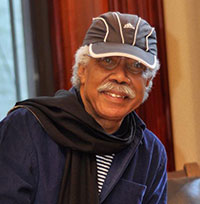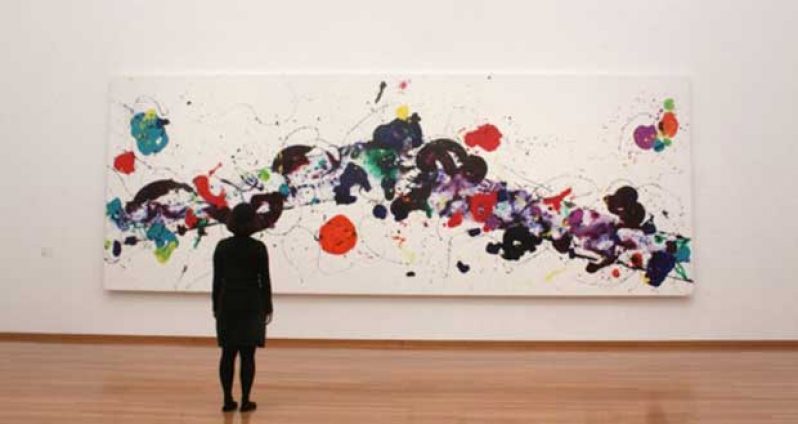by Terence Roberts
With abstract painting, reality became much more than what one saw, and free from any specific “real” representation of the artist’s race, nation, or society. It was more about what one felt and thought about what one saw.

“Real” representations of societies and nations largely became the subject matter of photography and cinema. The international appeal and adoption of abstract painting is therefore linked to thinking, feeling, experiencing sensations, dreams, even logic, unrestricted by specific racial, geographical, or cultural information.
In one of the essential books on art: “The Eternal Present: The beginning of Art”, art historian S. Giedion wrote: “Like the symbol, abstraction comes into being with the beginning of art. It existed: nameless. It was simply there.”
Natural light anywhere linked painters to the realm of the tropical. Take Sam Francis, probably the moved loved and successful North American painter outside the USA, who made Paris and Tokyo his main bases of living and painting, while keeping a temporary studio in the USA.
A close friend of Riopelle in Paris, they share a similarity of INTENSE painting, but not painting method. Whereas Riopelle mastered the palette knife, Francis mastered brushes related to diverse cultures, particularly Japanese. He immersed his senses in the tropical environments of countries like Mexico, India, Japan, the Philippines, Korea, Hong Kong, China.

Working endlessly on canvas and paper, his paintings became miracles of vision influenced by an alchemy of mobile shapes and colours shot through with atmospheric tropical shadow and light, placing the viewer on the borderline of “now you see it, now you don’t” psychological perception.
The paintings of Sam Francis convey enormous happiness by their sheer sincerity. Like many of the great abstract painters, he absorbed and conveyed philosophical strength by reading philosophy; in his case it was mostly the psychological writings of the famous philosopher Carl Jung.
There is the story of a bright abstract Sam Francis painting which made a lady recover from persistent depression upon seeing it. The work acted like the psychic medicine of a primitive shaman. His abstract paintings find appreciation among the Japanese, citizens of Hong Kong, Manila, Mexico, etc, where they are exhibited to people who recognize their tropical values. And where exactly is Sam Francis from? Sunny and cosmopolitan California.
Apart from their overall spirit of light, the works of Riopelle, Francis, or Hunderwasser are filled with details which demand viewer contemplation They are not mere wall décor. Who would have thought that Hunderwasser from Austria’s capital, Vienna, would revive contemporary painting as an intense individual act beyond all styles, all schools, linking his works to an informal use of tropical color and structure? Art criticism therefore met an impasse before Hunderwasser’s paintings. We can say that his famous spirals cripple the intellectual need for academic art criticism.
He once wrote: “The spiral lies at the very point where inanimate matter is transformed into life. Our whole life proceeds in spirals. Progress is regress and regress becomes progress.”
Hundertwasser lived for the sun, sailed around the world in his small schooner, and moved permanently to New Zealand. He painted non-stop everywhere without embarrassment. Apart from visiting and painting in 32 tropical countries in Africa, Asia, the Far East and South America, he designed three tropical postage stamps for Senegal at the invitation of its then president Leopold Senghor, a profound African poet.
He also brilliantly transformed parts of Vienna into a green tropical city of rooftop vegetation and appropriate calm minimal architectural painting and design; the complete opposite of trendy garish and frenetic urban murals which project social issues on the public, rather than resolve them in painting.
Influences related to “primitive” tropical values of informal, intuitive creativity, were part of the COBRA group of post-war Scandinavian semi-abstract painters: Appel, Corneille, Alechinsky, Rooskens and Jorn and others, from the cities of Copenhagen, Brussels, and Amsterdam. For these exciting artists modern painting was not the repetition and mastery of academic rules, but an open-minded maintenance of direct, intuitive surprise painting, liberated and guided by their hands and eyes confident in themselves. Such freedom was more refined in Italy, where Santomaso, Afro Basaldella, and Corpora’s abstract paintings led the way in acute sensitivity out of Italy’s huge Art History, dispersing southern Italian light with brilliant painterly effects.
In South America, painting obviously became both a product of tropical culture and an influence on it. But other styles of painting tended to dominate, and historical issues of politics, historical ambitions, illiteracy, crime, corruption, and indifference over-shadowed the social potential of a tropical form of painting. Exceptions include Rufino Tamayo of Mexico, a Zapotec Indian internationally celebrated as a giant of 20th century painting. Cuba’s Wifredo Lam opened a whole new surreal tropical style of painting with “The Jungle.”
And Venezuela’s Armando Reveron with humane foresight asserted the essence of Venezuelan tropical life by rejecting the political topics and social and historical obsessions of his nation.
Reveron began to live and paint in the seacoast village of Macuto in a humble hut like a wise hermit. There his dazzling history-making monochromatic canvasses emerged with their dazzling seacoasts, beaches, trees, huts, waves, and also voluptuous nudes of ordinary women, all of which preserved the joy of planetary tropical values as a celebrated truth in Venezuelan painting.
In Peru, De Syzslo, and in Columbia, Obregon, came to represent the best examples of internationally famous South American painters of tropical values. In Guyana, tropical abstraction in the exceptional hands of Aubrey Williams, Frank Bowling, and Cletus Henriques grasped the national/cultural identity in its widest organic truth. In a nation where such an achievement is diminished by a barrage of diverse ethnic cultural interests and much needed curatorial focus, Williams’ mature organic abstract paintings reflect the nation’s terrestrial effect on humble surfaces and sites weathered by the elements; Bowling’s monochromatic works on the other hand stun with their deep cosmic understanding of color, surface, and especially the movement of water, culled from a intensely felt Guyanese landscape; Henriques’ glowing canvasses repeat rich isolated forms of color projected from deep within his country’s mineral wealth; they are done with palette knives, Henriques’ unique skill in Guyanese painting, which is linked to this Guyanese artist’s Portuguese heritage’s traditional mastery of applying plaster and stucco.
One comprehensive exhibition and catalogue of there three artists’ mature tropical abstract paintings remains needed to harvest their brilliant examples of how tropical culture defines the Guyanese national identity, and uplifts their culture to its inherited world view.



.jpg)










